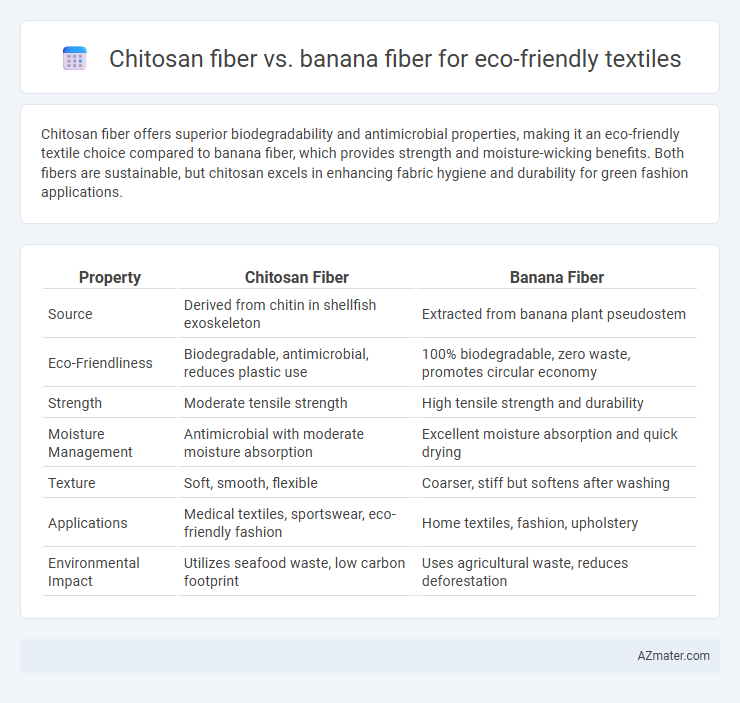Chitosan fiber offers superior biodegradability and antimicrobial properties, making it an eco-friendly textile choice compared to banana fiber, which provides strength and moisture-wicking benefits. Both fibers are sustainable, but chitosan excels in enhancing fabric hygiene and durability for green fashion applications.
Table of Comparison
| Property | Chitosan Fiber | Banana Fiber |
|---|---|---|
| Source | Derived from chitin in shellfish exoskeleton | Extracted from banana plant pseudostem |
| Eco-Friendliness | Biodegradable, antimicrobial, reduces plastic use | 100% biodegradable, zero waste, promotes circular economy |
| Strength | Moderate tensile strength | High tensile strength and durability |
| Moisture Management | Antimicrobial with moderate moisture absorption | Excellent moisture absorption and quick drying |
| Texture | Soft, smooth, flexible | Coarser, stiff but softens after washing |
| Applications | Medical textiles, sportswear, eco-friendly fashion | Home textiles, fashion, upholstery |
| Environmental Impact | Utilizes seafood waste, low carbon footprint | Uses agricultural waste, reduces deforestation |
Introduction to Eco-Friendly Textiles
Eco-friendly textiles prioritize sustainable materials like chitosan fiber and banana fiber, which reduce environmental impact through biodegradability and renewable sourcing. Chitosan fiber, derived from shellfish waste, offers antimicrobial properties and enhanced moisture management, making it suitable for functional clothing. Banana fiber, extracted from banana plant stems, provides durability and natural breathability, promoting waste reduction and resource efficiency in textile production.
Overview of Chitosan Fiber
Chitosan fiber, derived from chitin found in crustacean shells, offers exceptional biodegradability and antimicrobial properties, making it ideal for eco-friendly textiles. Its natural origin and biocompatibility contribute to reduced environmental impact compared to synthetic fibers, while enhancing fabric durability and hygiene. In contrast to banana fiber, chitosan fiber provides superior moisture management and odor resistance, aligning with sustainable fashion industry demands.
Overview of Banana Fiber
Banana fiber, derived from the pseudostems of banana plants, offers a sustainable and biodegradable alternative to conventional textile fibers. This natural fiber is prized for its strength, durability, and breathability, making it suitable for eco-friendly fabric production. Rich in cellulose and requiring minimal chemical processing, banana fiber reduces environmental impact compared to synthetic fibers and supports waste valorization in the agricultural sector.
Environmental Impact: Chitosan vs Banana Fiber
Chitosan fiber, derived from crustacean shells, exhibits strong biodegradability and antimicrobial properties, reducing the need for chemical treatments in textiles and minimizing environmental pollution. Banana fiber, extracted from banana plant pseudostems, is a renewable, biodegradable material that requires low water and pesticide inputs, offering a sustainable alternative to conventional fibers. Both fibers contribute to eco-friendly textiles, but banana fiber's agricultural waste utilization and lower resource demand provide a more sustainable environmental impact compared to chitosan fiber production.
Production Process Comparison
Chitosan fiber production involves extracting chitin from crustacean shells, followed by deacetylation and fiber spinning processes that require chemical treatments and enzymatic reactions, ensuring biodegradability and antimicrobial properties. Banana fiber is derived from the pseudostems of banana plants through mechanical extraction, retting, and drying, emphasizing minimal chemical use and promoting renewable waste utilization. Both fibers offer sustainable textile options, with chitosan's production reliant on marine waste processing and banana fiber capitalizing on agricultural byproducts, impacting energy consumption and environmental footprint differently.
Biodegradability and Sustainability
Chitosan fiber, derived from crustacean shells, offers excellent biodegradability through natural microbial degradation, making it highly sustainable for eco-friendly textiles. Banana fiber, extracted from banana plant stems, is also fully biodegradable and promotes sustainability by utilizing agricultural waste, reducing environmental impact while supporting circular economy practices. Both fibers contribute to sustainable textile production by minimizing landfill waste and lowering reliance on synthetic materials.
Textile Properties and Performance
Chitosan fiber exhibits excellent antibacterial properties, high moisture absorption, and biodegradability, making it ideal for eco-friendly textiles requiring hygiene and comfort. Banana fiber offers remarkable tensile strength, durability, and natural UV resistance, suitable for robust fabrics and outdoor applications. Both fibers demonstrate sustainable production methods, but chitosan's bioactive properties differentiate it from banana fiber in performance-critical textile uses.
Applications in the Fashion Industry
Chitosan fiber, derived from crustacean shells, offers antimicrobial and biodegradable properties ideal for sustainable fashion applications such as activewear and medical textiles. Banana fiber, sourced from banana plant pseudostems, provides natural strength and breathability, making it suitable for eco-friendly casual wear and accessories. Both fibers contribute to reducing environmental impact by replacing synthetic materials with renewable, compostable alternatives in the fashion industry.
Economic and Social Considerations
Chitosan fiber offers higher economic potential due to its antimicrobial properties, which reduce processing costs and add value to eco-friendly textiles, benefiting industries and consumers alike. Banana fiber, derived from agricultural waste, supports rural economies by providing income for farmers and promoting sustainable farming practices in banana-growing regions. Both fibers contribute socially by enabling eco-conscious employment opportunities, but banana fiber's integration into traditional crafts often sustains cultural heritage more directly.
Future Prospects and Innovations
Chitosan fiber, derived from crustacean shells, offers exceptional antimicrobial properties and biodegradability, making it a promising candidate for sustainable textiles that combat odor and bacterial growth. Banana fiber, obtained from agricultural waste, boasts high tensile strength and moisture absorption, ideal for eco-friendly fabrics promoting waste valorization and reducing reliance on synthetic fibers. Future innovations focus on blending these fibers with nanomaterials and enhancing their functional properties to expand applications in smart textiles and medical fabrics.

Infographic: Chitosan fiber vs Banana fiber for Eco-friendly textile
 azmater.com
azmater.com